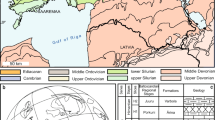Abstract
The Cuban macaw Ara tricolor (Bechstein, 1811) is an extinct species of large parrots. Its historical distribution and ecology are poorly understood. To date, only three late Quaternary paleontological and one archeozoological (17th–18th centuries) finds of the species have been described from central Cuba. A new (fourth) fossil find of the Cuban macaw is described and is a fragmentary carpometacarpus from Upper Pleistocene layers of the El Abrón Cave in the Pinar del Río province. The find provides the first documented evidence of the species from the western part of Cuba. The associated fauna indicates that the Cuban macaw lived in mosaic, semi-open marshy landscapes, which were probably similar to those in the vicinity of Ciénaga de Zapata in modern times.


Similar content being viewed by others
REFERENCES
Olson, S.L. and Suarez, W., A fossil cranium of the Cuban Macaw Ara tricolor (Aves: Psittacidae) from Villa Clara Province, Cuba, Caribb. J. Sci., 2008, vol. 44, pp. 287–290.
Olson, S.L. and Maíz López, E., New evidence of Ara autochthones from an archaeological site in Puerto Rico: a valid species of West Indian macaw of unknown geographical origin (Aves: Psittacidae), Caribb. J. Sci., 2008, vol. 44, pp. 215–222.
Williams, M.I. and Steadman, D.W., The historic and prehistoric distribution of parrots (Psittacidae) in the West Indies, in Biogeography of the West Indies: Patterns and Perspectives, Wood, C.A. and Sergile, F.E., Eds., Boca Raton: CRC Press, 2001, pp. 175–190.
Wiley, J.W. and Kirwan, G.M., The extinct macaws of the West Indies, with special reference to Cuban Macaw Ara tricolor, Bull. Br. Ornithol. Club, 2013, vol. 133, no. 2, pp. 125–156.
Gala, M. and Lenoble, A., Evidence of the former existence of an endemic macaw in Guadeloupe, Lesser Antilles, J. Ornithol., 2015, vol. 156, no. 4, pp. 1061–1066.
Orihuela, J., An annotated list of late Quaternary extinct birds of Cuba, Ornitol. Neotrop., 2019, vol. 30, pp. 57–67.
Barbour, T., The Birds of Cuba, Cambridge: Nuttal Ornithol. Club, 1923.
Jiménez, O. and Orihuela, J., New findings of birds in paleontological and archaeological contexts of Cuba, Novitates Caribaea, 2021, vol. 17, pp. 163–176.
Suárez, W. and Díaz-Franco, S., A new fossil bat (Chiroptera: Phyllostomidae) from a Quaternary cave in Cuba, Caribb. J. Sci., 2003, vol. 39, pp. 371–377.
Suárez, W., The Enigmatic Snipe Capella sp. (Aves: Scolopacidae) in the Fossil Record of Cuba, Caribb. J. Sci., 2004, vol. 40, no. 1, pp. 155–157.
Suárez, W. and Díaz-Franco, S., Estudio paleontológico del depósito fosilífero El Abrón, Pinar del Río (Sinopsis de las aves fósiles de Cueva El Abrón, Pinar del Río, Cuba), in Biodiversidad Paleontológica del Archipiélago Cubano: Bases Cartográficas y Conservacionistas. Informe Final del Proyecto 022 AMA-CITMA; 074 MNHN, La Havana: Museo National de Historia Natural Cubana, 2011.
Zelenkov, N.V. and Gonzalez, S.F., The first fossil tody (Aves: Todidae) from Cuba, Paleontol. J., 2020, vol. 54, pp. 414–419.
Syromyatnikova, E., Aranda, E., and Fiol González, S., First insight into the diversity of snakes in the Pleistocene of Cuba, Acta Palaeontol. Pol., 2021, vol. 66, pp. 395–407.
Zelenkov, N.V. and Gonzalez, S.F., A new extinct species of Margarobyas (Strigiformes) and the evolutionary history of the endemic Cuban bare-legged owl (M. lawrencii), J. Vertebr. Paleontol., 2021, vol. 41, p. e1995869. https://doi.org/10.1080/02724634.2021.1995869
Lopatin, A.V., Dental Replacement in Nesophontidae (Lipotyphla, Mammalia) from the Pleistocene of Cuba, Dokl. Biol. Sci., 2023, vol. 497, pp. 45–50.
Zelenkov, N.V. and Belichenko, E.S., Dynamics of the Late Quaternary avifauna of Western Cuba (Based on Material from El Abrón Cave), Dokl. Biol. Sci., 2022, vol. 503, pp. 54–57.
Rosina, V.V., Lopatin, A.V., Agadzhanyan, A.K., and Fiol Gonzalez, S., New records of bats (Chiroptera, Mammalia) from the Pleistocene El Abrón Locality (Cuba), Paleontol. J., 2023, Vol. 57, pp. 83–91.
Rojas Consuegra, R., Pajón Morejón, J.M., Aranda Pedroso, E., et al., Estratigrafía del yacimiento cuaternario de microvertebrados fósiles El Abrón, en el karst de Sierra La Güira, provincia Pinar del Río, Cuba, Geociencias UO, 2022, vol. 5, no. 2, pp. 102–113.
Bush, M.B., Correa-Metrio, A., Hodell, D.A., et al., Re-evaluation of climate change in Lowland Central America during the Last Glacial Maximum using new sediment cores from Lake Petén Itzá, Guatemala, in Past Climate Variability from the Last Glacial Maximum to the Holocene in South America and Surrounding Regions, Vimeux, F., Sylvestre, F., Khodri, M., Eds., Berlin: Springer-Verlag, 2009, pp. 113–128.
Warken, S.F., Scholz, D., Spötl, Ch., et al., Caribbean hydroclimate and vegetation history across the last glacial period, Quat. Sci. Rev., 2019, vol. 218, pp. 75–90.
ACKNOWLEDGMENTS
The author is grateful to Academician A.V. Lopatin (Borissiak Paleontological Institute) for comments on the manuscript; A.K. Agadzhanyan, E.V. Syromyatnikova (Borissiak Paleontological Institute), R. Rojas Consuegra (Center of Oil Research, Havana, Cuba), J. Pajón Morejón, E. Aranda Pedroso, L.A. Barsaga Rodriguez, S. Fiol Gonzalez, and E. Peres Lorenzo (Cuban National Museum of Natural History) for field works at the site; E.S. Belichenko (Borissiak Paleontological Institute) for help in sorting the materials; and E.V. Syromyatnikova for help in map preparation.
Funding
Field works were supported by the Russian Foundation for Basic Research and SITMA (project no. 18-54-34004 “Late Quaternary Cuban Vertebrates: Relictual faunas on the Eve of the Holocene Extinction”).
Author information
Authors and Affiliations
Corresponding author
Ethics declarations
CONFLICT OF INTEREST
The author of this work declares that he has no conflicts of interest.
ETHICS APPROVAL AND CONSENT TO PARTICIPATE
This work does not contain any studies involving human and animal subjects.
Additional information
Translated by T. Tkacheva
Publisher’s Note.
Pleiades Publishing remains neutral with regard to jurisdictional claims in published maps and institutional affiliations.
Rights and permissions
About this article
Cite this article
Zelenkov, N.V. Cuban Macaw Ara tricolor in the Upper Pleistocene of Western Cuba. Dokl Biol Sci (2024). https://doi.org/10.1134/S0012496624700947
Received:
Revised:
Accepted:
Published:
DOI: https://doi.org/10.1134/S0012496624700947




